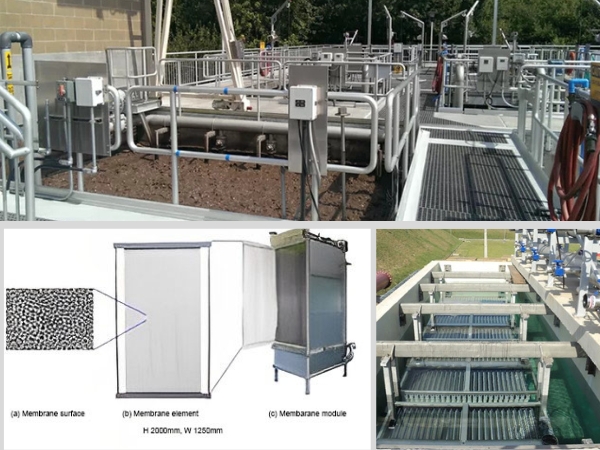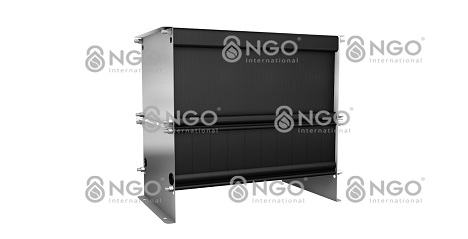MEMBRANE BIO-REACTOR WASTEWATER TREATMENT TECHNOLOGY (MBR)

1. Operating principle
- Membrane bioreactor is advanced wastewater technology using biological methods combined biomass separation technique using membranes MF / UF membranes with a pore size ranging from 0,1-0,4μm.
- Biological processes can be combined anaerobic-anoxic-aerobic (AAO, AO) depending on the required treatment or processing of organic matter thoroughly both nutrients (N, P).
2. Advantages's use membrane bioreactor wastewater treatment technology
- Membrane bioreactor technology works with long SRT (sludge retention time), high MLSS and low ratio of F/M
- Quality of treated water does not depend on sludge deposition
- MBR has higher nitrification compared with conventional activated sludge process, because it takes bacteria longer time to conduct nitrification (SRT length, F / M Low)
- The size of sludge cotton in the MBR sludge is small, allowing more metabolism of nutrients and oxygen.
- The presence of the membranes in an MBR prevent leaching nitrifying microorganisms at short SRT and HRT
- MBR generates less sludge
- MBR process can treat higher polution load (from 2.5 to 3 times higher than polution load of CAS)
- Reduce footprint of the whole system 50% compared to conventional processes, Eleminate many steps of CAS process such as: secondary settlement, concentrated sludge, or other measures to remove more thoroughly BOD, SS
- Treatment efficiency of microorganisms is very high, minimize the risks of infection, do not use disinfection chemicals
- Less energy consumption
- Excellent effluent quality, water after MBR process can be reused for many purposes such as irrigation, clean floor, toilet, etc
- MBR has absolute advantage compared to other solutions in term of footprint.

3. Disadvantages's use MBR wastewater treatment technology
- Higher initial investment and operating cost if membrane's quality is not good which causes membrane fouling & clogging
- Operation is complicated in term of cleaning membrane, require skilled operator to operate the system if membrane does not apply automatic cleaning (both by aeration or by chemical liquid)
If your business is interested in solution to inlet water treatment, or has a demand for ion exchange materials, please contact NGO via phone number (024) 3566 8225 or email office@8ngo.com for direct consultation.
Source: NGO
thong_tin_lien_quan
-
 Wastewater treatment
Wastewater treatment
-
 A standard domestic wastewater
A standard domestic wastewater
-
 B standard domestic wastewater
B standard domestic wastewater
-
 Pig Farm Wastewater
Pig Farm Wastewater
-
 Textile dyeing wastewater
Textile dyeing wastewater
-
 Paper industry wastewater solution
Paper industry wastewater solution
-
 Textile Dyeing Wastewater & Industrial Washing
Textile Dyeing Wastewater & Industrial Washing
-
 Slaughter wastewater treatment solution
Slaughter wastewater treatment solution
-
 Aquaculture wastewater
Aquaculture wastewater
-
 Starch wastewater
Starch wastewater
-
 Petroleum wastewater
Petroleum wastewater
-
 Beer wastewater
Beer wastewater
-
 Other industrial wastewaters
Other industrial wastewaters
-
 BioPM - Organic Industrial wastewater treatment solution
BioPM - Organic Industrial wastewater treatment solution
-
 MBR solutions
MBR solutions
-
 Conventional activated sludge (CAS)
Conventional activated sludge (CAS)
-
 Moving bed biofilm reactor (MBBR)
Moving bed biofilm reactor (MBBR)
-
 Anaerobic- Anoxic-Aerobic (AAO)
Anaerobic- Anoxic-Aerobic (AAO)
-
 Sequencing batch reactor (SBR)
Sequencing batch reactor (SBR)
-
 Physical & Chemical methods
Physical & Chemical methods
-
 Supply water treatment
Supply water treatment
-
 Cooling system water
Cooling system water
-
 Water treatment for food and Beverage production
Water treatment for food and Beverage production
-
 Ultra pure water supply solution for electronic industry
Ultra pure water supply solution for electronic industry
-
 Pure water supply for pharmaceutical manufacturers
Pure water supply for pharmaceutical manufacturers
-
 Water Supply treatment with ion exchange method
Water Supply treatment with ion exchange method
-
 Ordor Treatment
Ordor Treatment



